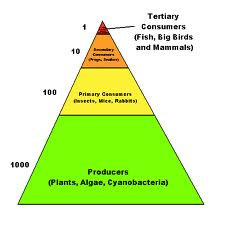Structure of Ecosystems
An Ecosystem is a dynamic, stable system characterised by the interaction of plants and animals with each other and with the non-living components of the environment
The components of an ecosystem are categorised as either biotic and abiotic
Biotic
Biotic means the living environment, components include:
- Vegetation (living and decomposing)
- Mammals, insects, birds and microorganisms
Biomass is the mass of material in the bodies of animals and plants (total mass of living matter)
Abiotic
Abiotic means the non-living, chemical and physical components of the ecosystem and includes:
- Climate- in particular the seasonal pattern of temperature and precipitation
- Soil characteristics
- Underlying parent rock
- Relief of the land
- Drainage characteristics
Ecosystems are open systems because energy and living matter can both enter and leave the system:
- Inputs - Energy from the sun, which drives photosynthesis-enabling the plants to grow, water transported into the ecosystem from precipitation and animals that arrive from elsewhere
- Outputs - nutrients are transferred out of the system by: animals can physically move out, water can leave through evapotranspiration, groundwater flow and throughflow
- Flows - nutrients can be transferred from one store to another e.g. capillary uptake
- Stores- stores of nutrients: vegetation, plant litter and soils
Energy Flows and nutrient cycling
Energy flows arethe flow of energy through a food chain
- Energy flows flow through an ecosystem from one stage to another.
- Through photosynthesis plants are able to capture light energy from the sun to make carbohydrates from carbon dioxide and water to grow and increase their biomass
- Within all ecosystems, nutrients are required for plant growth and are recycled from one store to another
e.g. leaves fall from tree-> when they decompose nutrients are returned to the soil
Trophic levels, food chains and webs
Energy transfer within an ecosystem, represented by a pyramid diagram

- At each trophic level, some energy is available as food for the next level
- Each level decreases in size, 90% of energy lost through life processes-respiration, movement and excretion
- Only 10% available as food, number of living organisms decreases as trophic levels increase
- Producers/autotrophs - first layer, produce their own food through photosynthesis(green plants)
- Primary consumers -eat the producers(herbivores)
- Secondary consumers - consume the herbivores(carnivores)
- Tertiary consumers - top predators that eat secondary consumers
